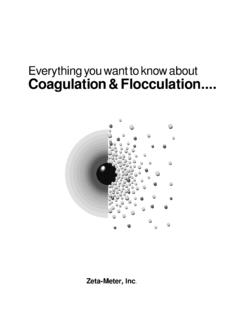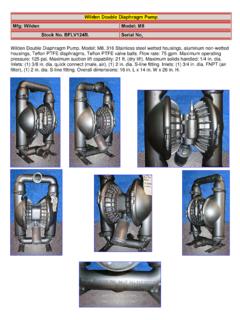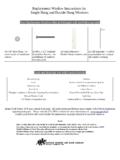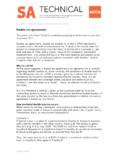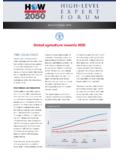Transcription of Zeta Potential: A Complete Course in 5 Minutes
1 zeta -Meter andColloid BehaviorZeta potential can help youunderstand and control colloidalsuspensions. Examples includecomplex biological systems such asblood and functional ones like suspensions can be asthick as paste (like cement) or asdilute as the turbidity particles ina lake. Water, milk, wine, clay,dyes, inks, paper and pharmaceu-ticals are good examples of usefulcolloidal systems. Water is a com-mon suspending liquid, althoughnon-aqueous liquids are used aswell. In many cases, the perform-ance of a suspension can be im-proved by understanding the effectof colloidal behavior on such prop-erties as viscosity, settling andeffective particle can often tailor the charac-teristics of a suspension by under-standing how individual colloidsinteract with one another.
2 At timeswe may want to maximize thebehavior of concentrated suspen-sions. On standing, a weak matrixof flocculant particles is prevents the closely packedsediment that would form andcause caking problems if the par-ticles were highly stabilized andremained completely forces at the interface ofthe particle and the liquid are veryimportant because of the micro-scopic size of the colloids. One ofthe major surface effects is elec-trokinetic. Each colloid carries a like electrical charge which pro-duces a force of mutual electro-static repulsion between adjacentparticles.
3 If the charge is highenough, the colloids will remaindiscrete, disperse and in suspen-sion. Reducing or eliminating thecharge has the opposite effect the colloids will steadily agglomer-ate and settle out of suspension orform an interconnected agglomeration causes thecharacteristics of the suspensionto charge can be controlledby modifying the suspending liq-uid. Modifications include chang-ing the liquid s pH or changing theionic species in solution. Another,more direct technique is to use sur-face active agents which directlyadsorb to the surface of the colloidand change its Particles are free tocollide and forces between them inorder to keep each particle discreteand prevent them from gatheringinto larger, faster settling agglom-erates.
4 Examples include pharma-ceuticals and pastes. Sometimeswe have the opposite goal and wantto separate the colloid from theliquid. Removing the repulsiveforces allows them to form largeflocs that settle fast and filter eas-ily. Viscosity is another propertythat can be modified by varying thebalance between repulsion and some cases, an in-betweenstate of weak aggregation can bethe best solution. Paints are a goodexample. Here, the weak aggrega-tion causes viscosity to be a func-tion of shear rate. Stirring willproduce enough shear to reducethe viscosity and promote aggregation is alsouseful in controlling the settlingThe Interaction of ColloidsZeta Potential: A Complete Course in 5 MinutesCharged Particles repel each diffuse layer can be visualized as a chargedatmosphere surrounding the double LayerThe double layer model is usedto visualize the ionic environmentin the vicinity of a charged colloidand explains how electrical repul-sive forces occur.
5 It is easier tounderstand this model as a se-quence of steps that would takeplace around a single negative col-loid if its neutralizing ions weresuddenly stripped first look at the effect of thecolloid on the positive ions (oftencalled counter-ions) in , attraction from the nega-tive colloid causes some of the posi-tive ions to form a firmly attachedlayer around the surface of thecolloid; this layer of counter-ions isknown as the Stern positive ions are stillattracted by the negative colloid,but now they are repelled by theStern layer as well as by otherpositive ions that are also trying toapproach the colloid.
6 This dynamicequilibrium results in the forma-tion of a diffuse layer of counter-ions. They have a high concentra-tion near the surface which gradu-ally decreases with distance, untilit reaches equilibrium with thecounter-ion concentration in a similar, but opposite, fash-ion there is a lack of negative ionsin the neighborhood of the surface,because they are repelled by thenegative colloid. Negative ions arecalled co-ions because they havethe same charge as the concentration will graduallyincrease with distance, as the re-pulsive forces of the colloid arescreened out by the positive ions,until equilibrium is again diffuse layer can be visual-ized as a charged atmosphere sur-rounding the colloid.
7 The chargedensity at any distance from thesurface is equal to the difference inconcentration of positive and nega-tive ions at that point. Chargedensity is greatest near the colloidand gradually diminishes towardzero as the concentration of posi-tive and negative ions merge attached counter-ions in theStern layer and the charged at-mosphere in the diffuse layer arewhat we refer to as the doublelayer. The thickness of this layerdepends upon the type and concen-tration of ions in LayerDiffuse LayerHighly NegativeColloidIons In EquilibriumWith SolutionNegative Co-IonPositive Counter-IonTwo Ways to Visualize the DoubleLayerThe left view shows the change incharge density around the colloid.
8 Theright shows the distribution of positiveand negative ions around the PotentialThe double layer is formed inorder to neutralize the charged col-loid and, in turn, causes an elec-trokinetic potential between thesurface of the colloid and any pointin the mass of the suspending liq-uid. This voltage difference is onthe order of millivolts and is re-ferred to as the surface magnitude of the surfacepotential is related to the surfacecharge and the thickness of thedouble layer. As we leave the sur-face, the potential drops off roughlylinearly in the Stern layer and thenexponentially through the diffuselayer, approaching zero at theimaginary boundary of the doublelayer.
9 The potential curve is usefulbecause it indicates the strength ofthe electrical force between par-ticles and the distance at whichthis force comes into charged particle will move witha fixed velocity in a voltage phenomenon is called electro-phoresis. The particle s mobility isrelated to the dielectric constantand viscosity of the suspending liq-uid and to the electrical potentialat the boundary between the mov-ing particle and the liquid. Thisboundary is called the slip planeand is usually defined as the pointwhere the Stern layer and the dif-fuse layer meet.
10 The Stern layer isThe electrokinetic potential between thesurface of the colloid and any point in themass of the suspending liquid is referredto as the surface potential vs. Surface PotentialThe relationship between zetapotential and surface potentialdepends on the level of ions in of Ion Density in theDiffuse LayerThe figures above are two representa-tions of the change in charge densitythrough the diffuse layer. One showsthe variation in positive and negativeion concentration with distance from anegative colloid. The second showsthe net effect the difference inpositive and negative charge to be rigidly attached tothe colloid, while the diffuse layeris not.
